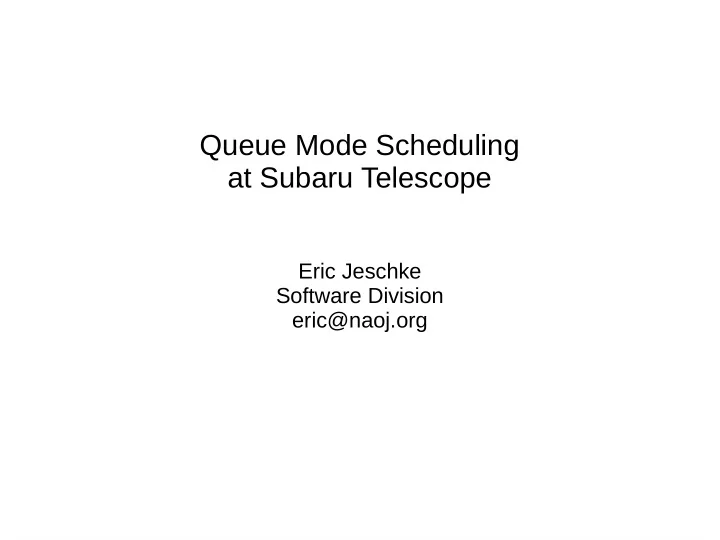

Queue Mode Scheduling at Subaru Telescope Eric Jeschke Software Division eric@naoj.org
Queue Scheduling ● Subaru's plan is to use automated queue scheduling, guided by human oversight ● To schedule a night in queue mode, we schedule the queue-available time with a constraint satisfaction/weighted scores algorithm
Observation Blocks ● Observers submit Observation Blocks (OBs) in the phase 2 part of their proposal ● Each OB defines a quantum of observation: – specifies enough information to observe a single target (with dithering) with a telescope, instrument and environment configuration ● This set of OBs defines the observation program
Scheduling Algorithm ● Scheduling algorithm is based on two kinds of criteria: – Fixed constraints —conditions that must be obeyed strictly for an OB to be considered a candidate for execution, and – Weighted scores —candidate OBs are sorted by calculating a total weighted score based on several factors
Examples of fixed constraints ● PI specifies an OB with an environment configuration that has a seeing value of 0.8 → Current seeing must be 0.8 or better to consider this OB a candidate for execution ● PI specifies an OB with a moon phase of “dark” → Illumination of moon on this night must be less than 25% to consider this OB a candidate for execution
Fixed constraints ● Target visibility at desired observing airmass ● Installed filters ● Desired seeing ● Desired sky condition (expressed as throughput ) ● Moon phase (dark, gray, any) ● Moon separation from target ● Time needed to complete OB
Examples of weighted factors ● PI specifies an OB with an instrument configuration specifying filter “i” → If the current filter is not “i”, then a filter change would need to be performed to execute this OB. Filter changes are expensive in terms of time (0.5 hr). Natural score is a function of time (lower = better) ● PI specifies an OB with a target configuration that would require a long slew from the current position → Long slews are expensive in terms of time. Natural score is a function of time to slew the telescope (lower = better) ● PI's proposal has a rank → Higher rank program are prioritized. Natural score is based on inverse of the rank (lower = better) ● All factors are designed so that natural score lower = better
Weights ● Each factor has a weight associated with it. This weight is multiplied by the natural score to get the weighted score for the factor ● The weighted scores are summed to get the total weighted score ● Candidates are sorted by total weighted score ● Lower scores are preferred ● Queue administrators decide the weights based on simulation results, experience using the queue and need to achieve desired queue policy and objectives
Weighted factors ● Program rank/grade ● Filter change time (filter changes somewhat expensive) ● Slew time to target (long slews inefficient) ● Delay time for target (long delays waste time) ● Observer's internal OB priority (only affects priority among that program's OBs)
Queue Scheduling Algorithm 1)A set of OBs are selected as candidates for a current time slot if he current conditions (telescope, instrument, environment) match the “fixed” constraints in the OB 2)The candidate OBs are sorted by the weighted score produced by combining several weighted factors 3)The least weighted (lowest score) OB is chosen for the slot and takes up a certain amount of time 4)Then the process iterates with the next available slot
Queue Simulation Results ● We created a tool for exploring queue scheduling, criteria, weighting ● Simulation was performed using historical SPCAM and current HSC observations ● Scheduling simulation results are consistent with the queue objectives, particularly with regard to completing high ranked programs ● Adjusting weights leads to expected outcomes ● This gives confidence the algorithm works for the goals
Summary ● We expect that the queue scheduling algorithm will evolve as we get more experience with it ● Weights may need to be tuned periodically for some practical realities (e.g. partner balance, etc.) ● Queue administrators (Science Operations) will be monitoring the queue closely and adjusting weights to maintain queue policy and objectives ● In the future, some fixed constraints might become weighted factors (e.g. seeing, transparency, etc)
Questions?
Recommend
More recommend